The Cambridge History of Japan, Vol. 1: Ancient Japan
Подождите немного. Документ загружается.

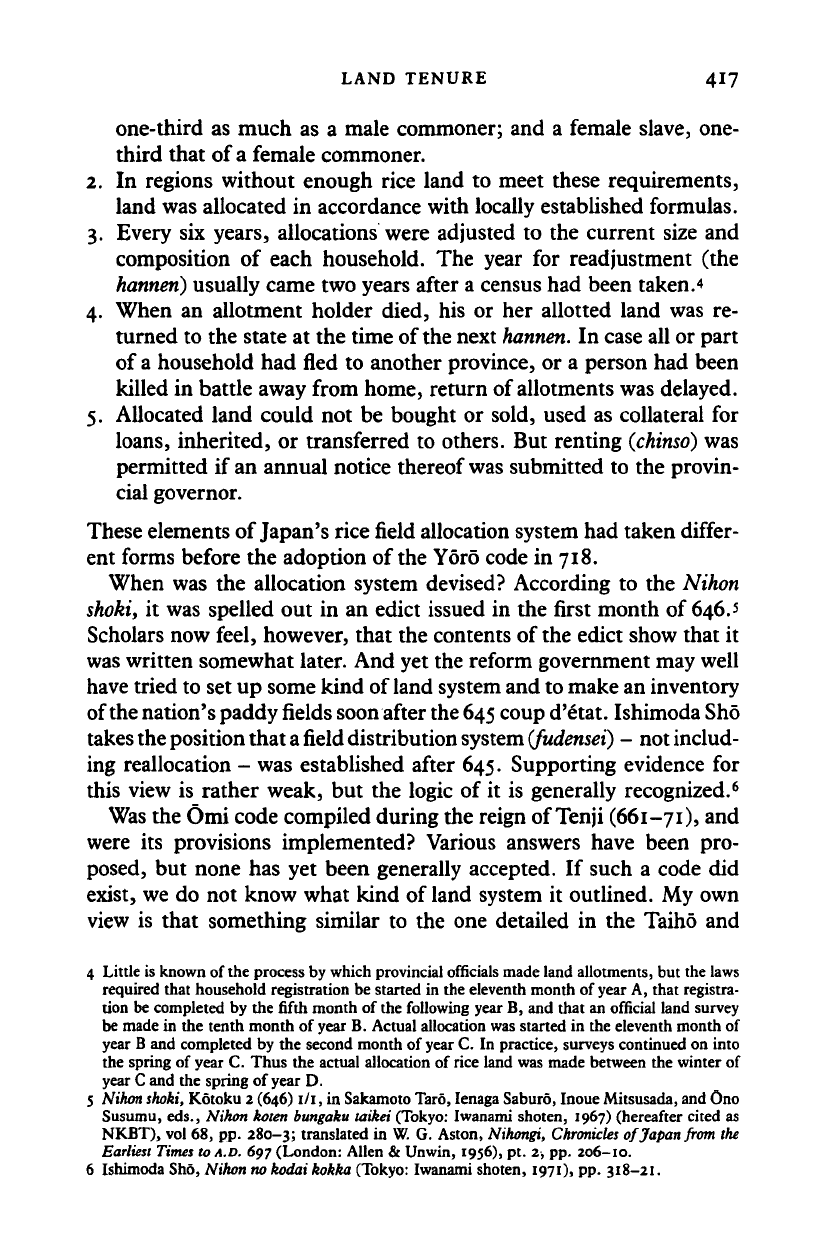
LAND TENURE 417
one-third as much as a male commoner; and a female slave, one-
third that of
a
female commoner.
2.
In regions without enough rice land to meet these requirements,
land was allocated in accordance with locally established formulas.
3.
Every six years, allocations were adjusted to the current size and
composition of each household. The year for readjustment (the
hannen)
usually came two years after a census had been taken.
4
4.
When an allotment holder died, his or her allotted land was re-
turned to the state at the time of the next
hannen.
In case all or part
of
a
household had fled to another province, or a person had been
killed in battle away from home, return of allotments was delayed.
5.
Allocated land could not be bought or sold, used as collateral for
loans,
inherited, or transferred to others. But renting
(chinso)
was
permitted if an annual notice thereof
was
submitted to the provin-
cial governor.
These elements of Japan's rice
field
allocation system had taken differ-
ent forms before the adoption of the Yoro code in 718.
When was the allocation system devised? According to the Nihon
shoki,
it was spelled out in an edict issued in the first month of 646.5
Scholars now feel, however, that the contents of the edict show that it
was written somewhat later. And yet the reform government may well
have tried to set up some kind of land system and to make an inventory
of
the
nation's paddy
fields
soon after
the 645
coup d'etat. Ishimoda Sho
takes
the position that a
field
distribution system
(fudensei)
- not includ-
ing reallocation - was established after 645. Supporting evidence for
this view is rather weak, but the logic of it is generally recognized.
6
Was the Omi code compiled during the reign of Tenji (661-71), and
were its provisions implemented? Various answers have been pro-
posed, but none has yet been generally accepted. If such a code did
exist, we do not know what kind of land system it outlined. My own
view is that something similar to the one detailed in the Taiho and
4 Little is known of the process by which provincial officials made land allotments, but the laws
required that household registration be started in the eleventh month of year A, that registra-
tion be completed by the fifth month of the following year B, and that an official land survey
be made in the tenth month of year B. Actual allocation was started in the eleventh month of
year B and completed by the second month of year C. In practice, surveys continued on into
the spring of year C. Thus the actual allocation of rice land was made between the winter of
year C and the spring of year D.
5 Nihon
shoki,
Kotoku 2 (646) 1/1, in Sakamoto Taro, Ienaga Saburo, Inoue Mitsusada, and Ono
Susumu, eds., Nihon koien bungaku taikei (Tokyo: Iwanami shoten, 1967) (hereafter cited as
NKBT), vol 68, pp. 280-3; translated in W. G. Aston, Nihongi,
Chronicles
of Japan from the
Earliest
Times
to
A.D.
697 (London: Allen & Unwin, 1956), pt. 2-, pp. 206-10.
6 Ishimoda Sho, Nihon no kodai kokka (Tokyo: Iwanami shoten, 1971), pp. 318-21.
Cambridge Histories Online © Cambridge University Press, 2008
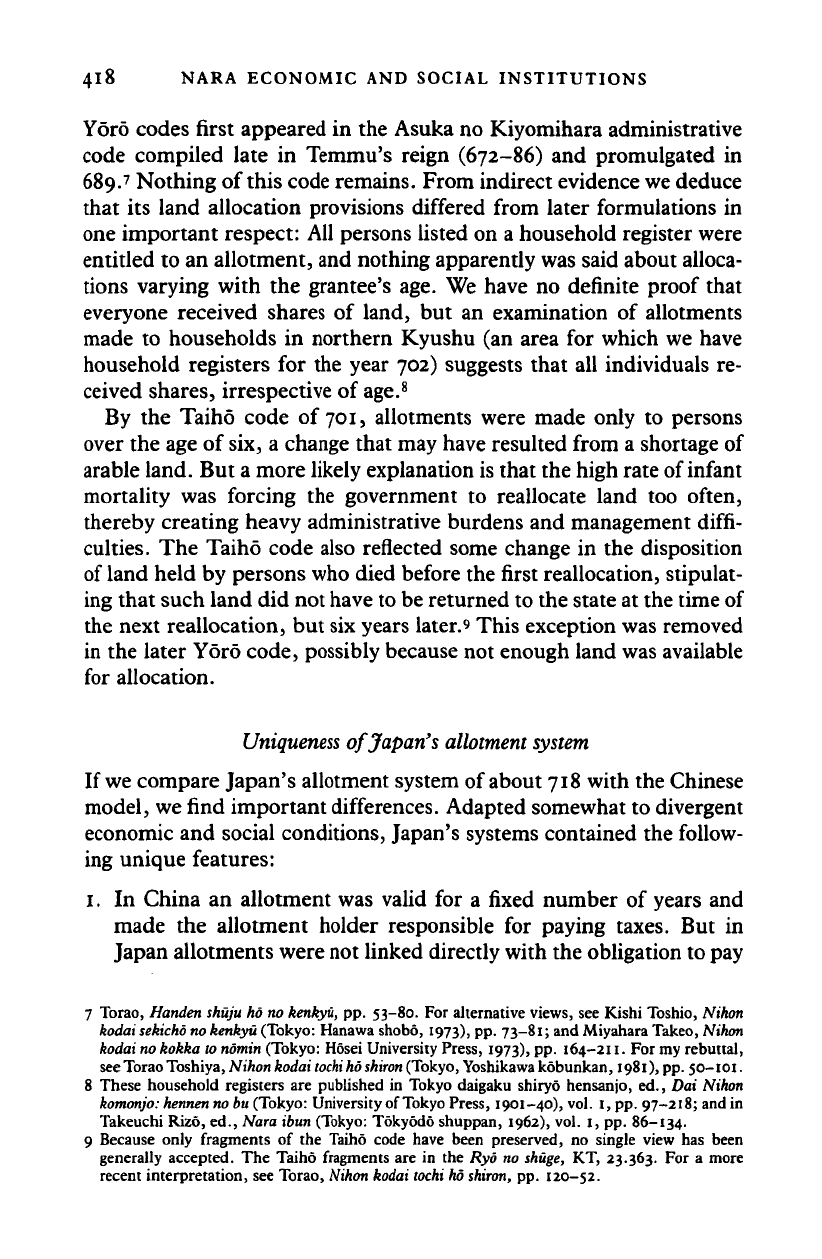
418 NARA ECONOMIC AND SOCIAL INSTITUTIONS
Yoro codes first appeared in the Asuka no Kiyomihara administrative
code compiled late in Temmu's reign (672-86) and promulgated in
68<).
7
Nothing of this code remains. From indirect evidence we deduce
that its land allocation provisions differed from later formulations in
one important respect: All persons listed on a household register were
entitled to an allotment, and nothing apparently was said about alloca-
tions varying with the grantee's age. We have no definite proof that
everyone received shares of land, but an examination of allotments
made to households in northern Kyushu (an area for which we have
household registers for the year 702) suggests that all individuals re-
ceived shares, irrespective of age.
8
By the Taiho code of
701,
allotments were made only to persons
over the age of six, a change that may have resulted from a shortage of
arable land. But a more likely explanation is that the high rate of infant
mortality was forcing the government to reallocate land too often,
thereby creating heavy administrative burdens and management diffi-
culties. The Taiho code also reflected some change in the disposition
of land held by persons who died before the first reallocation, stipulat-
ing that such land did not have to be returned to the state at the time
of
the next reallocation, but six years later.' This exception was removed
in the later Yoro code, possibly because not enough land was available
for allocation.
Uniqueness
of Japan's allotment system
If
we
compare Japan's allotment system of about 718 with the Chinese
model, we find important differences. Adapted somewhat to divergent
economic and social conditions, Japan's systems contained the follow-
ing unique features:
1.
In China an allotment was valid for a fixed number of years and
made the allotment holder responsible for paying taxes. But in
Japan allotments were not linked directly with the obligation to pay
7 Torao, Handen shuju ho no kenkyu, pp. 53-80. For alternative views, see Kishi Toshio, Nihon
kodai
sekicho
no kenkyu (Tokyo: Hanawa shobo, 1973), pp.
73-81;
and Miyahara Takeo, Nikon
kodai no kokka to
nomin
(Tokyo: Hdsei University Press, 1973), pp. 164-211. For my rebuttal,
see Torao Toshiya, Nihon kodai
tochi ho shiron
(Tokyo, Yoshikawa kobunkan, 1981), pp. 50-101.
8 These household registers are published in Tokyo daigaku shiryo hensanjo, ed., Dai Nihon
komonjo:
hennen
no bu (Tokyo: University of Tokyo Press, 1901-40), vol. I, pp. 97-218; and in
Takeuchi
RKO,
ed., Nara ibun (Tokyo: Tokyodo shuppan, 1962), vol. 1, pp. 86-134.
9 Because only fragments of the Taiho code have been preserved, no single view has been
generally accepted. The Taiho fragments are in the Ryo no
shuge,
KT, 23.363. For a more
recent interpretation, see Torao,
Nihon
kodai
tochi
ho
shiron,
pp. 120-52.
Cambridge Histories Online © Cambridge University Press, 2008
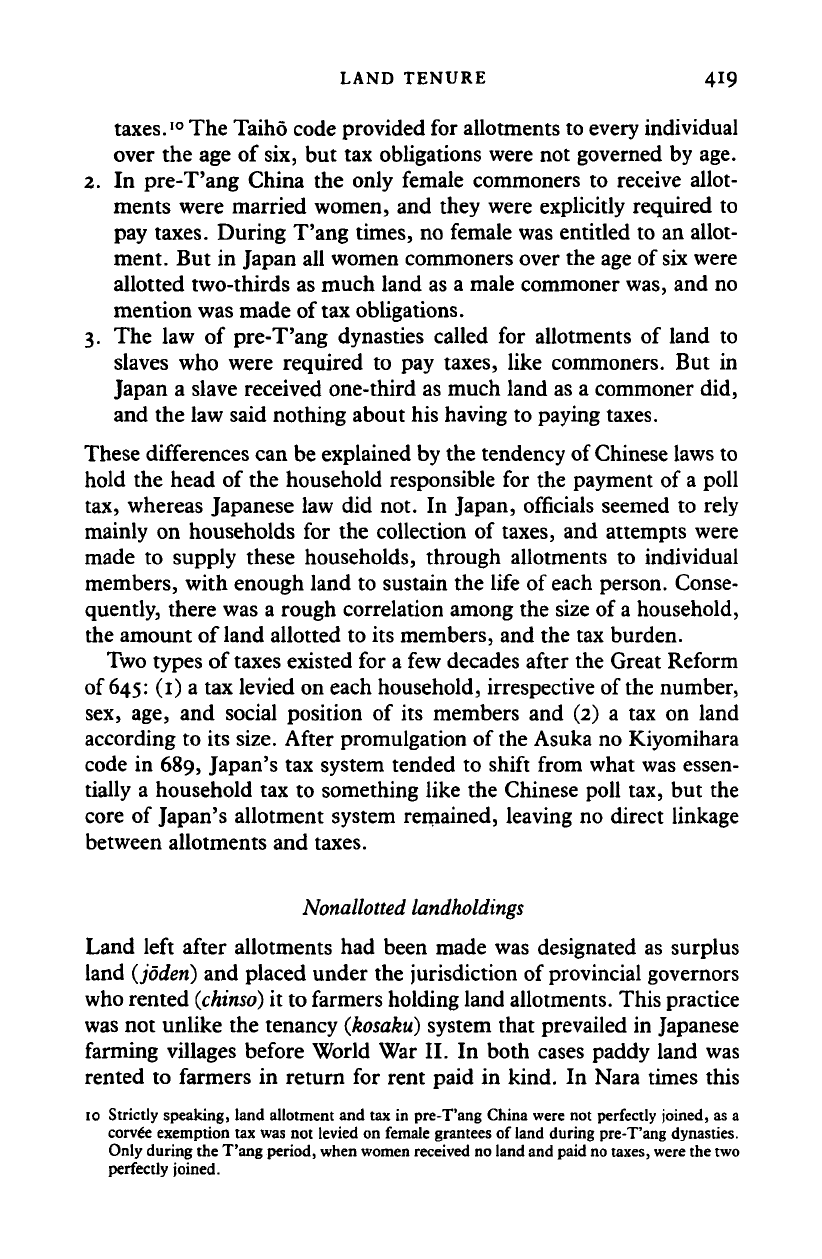
LAND TENURE 419
taxes.
10
The Taiho code provided for allotments to every individual
over the age of six, but tax obligations were not governed by age.
2.
In pre-T'ang China the only female commoners to receive allot-
ments were married women, and they were explicitly required to
pay taxes. During T'ang times, no female was entitled to an allot-
ment. But in Japan all women commoners over the age of
six
were
allotted two-thirds as much land as a male commoner was, and no
mention was made of tax obligations.
3.
The law of pre-T'ang dynasties called for allotments of land to
slaves who were required to pay taxes, like commoners. But in
Japan a slave received one-third as much land as a commoner did,
and the law said nothing about his having to paying taxes.
These differences can be explained by the tendency of Chinese laws to
hold the head of the household responsible for the payment of a poll
tax, whereas Japanese law did not. In Japan, officials seemed to rely
mainly on households for the collection of taxes, and attempts were
made to supply these households, through allotments to individual
members, with enough land to sustain the life of each person. Conse-
quently, there was a rough correlation among the size of
a
household,
the amount of land allotted to its members, and the tax burden.
Two types of taxes existed for a few decades after the Great Reform
of
645:
(1) a tax levied on each household, irrespective of the number,
sex, age, and social position of its members and (2) a tax on land
according to its size. After promulgation of the Asuka no Kiyomihara
code in 689, Japan's tax system tended to shift from what was essen-
tially a household tax to something like the Chinese poll tax, but the
core of Japan's allotment system remained, leaving no direct linkage
between allotments and taxes.
Nonallotted landholdings
Land left after allotments had been made was designated as surplus
land
(joderi)
and placed under the jurisdiction of provincial governors
who rented
(chinso)
it to farmers holding land allotments. This practice
was not unlike the tenancy
(kosaku)
system that prevailed in Japanese
farming villages before World War II. In both cases paddy land was
rented to farmers in return for rent paid in kind. In Nara times this
10 Strictly speaking, land allotment and tax in pre-T'ang China were not perfectly joined, as a
corvee exemption tax was not levied on female grantees of land during pre-T'ang dynasties.
Only during the T'ang period, when women received no land and paid no taxes, were the two
perfectly joined.
Cambridge Histories Online © Cambridge University Press, 2008
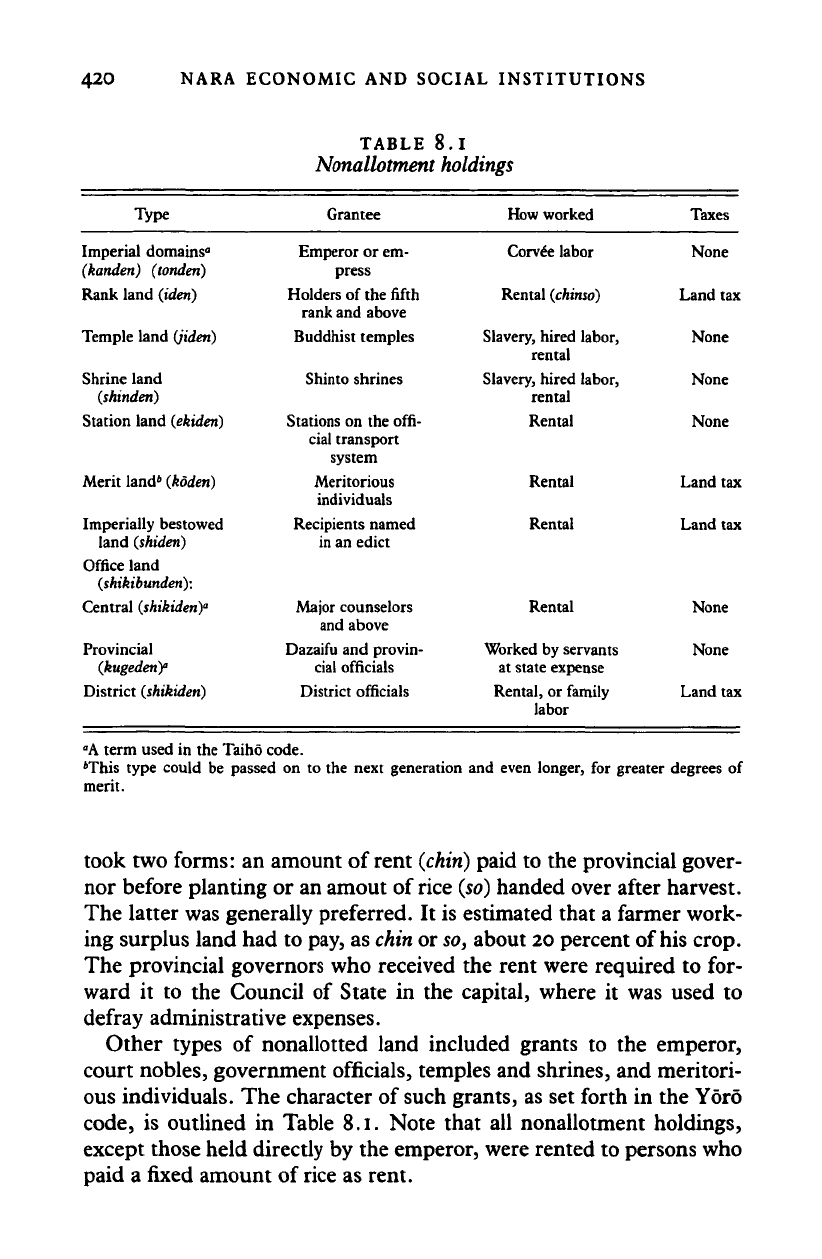
420
NARA ECONOMIC AND SOCIAL INSTITUTIONS
Type
Imperial domains"
(kanden) (londen)
Rank land (iden)
Temple land (jiden)
Shrine land
(shinderi)
Station land (ekiden)
Merit land' (koden)
Imperially bestowed
land (shiden)
Office land
(shikibunden):
Central (shikidenY
Provincial
(kugedetif
District (shikiden)
TABLE 8.
I
Nonalbtment holdings
Grantee
Emperor or em-
press
Holders of the fifth
rank and above
Buddhist temples
Shinto shrines
Stations on the offi-
cial transport
system
Meritorious
individuals
Recipients named
in an edict
Major counselors
and above
Dazaifu and provin-
cial officials
District officials
How worked
Corvee labor
Rental (chinso)
Slavery, hired labor,
rental
Slavery, hired labor,
rental
Rental
Rental
Rental
Rental
Worked by servants
at state expense
Rental, or family
labor
Taxes
None
Land tax
None
None
None
Land tax
Land tax
None
None
Land tax
"A term used in the Taiho code.
'This type could be passed on to the next generation and even longer, for greater degrees of
merit.
took two forms: an amount of rent
(chin)
paid to the provincial gover-
nor before planting or an amout of rice
(so)
handed over after harvest.
The latter was generally preferred. It is estimated that a fanner work-
ing surplus land had to pay, as
chin
or
so,
about 20 percent of his crop.
The provincial governors who received the rent were required to for-
ward it to the Council of State in the capital, where it was used to
defray administrative expenses.
Other types of nonallotted land included grants to the emperor,
court nobles, government officials, temples and shrines, and meritori-
ous individuals. The character of such grants, as set forth in the Yoro
code,
is outlined in Table 8.1. Note that all nonallotment holdings,
except those held directly by the emperor, were rented to persons who
paid a fixed amount of rice as rent.
Cambridge Histories Online © Cambridge University Press, 2008
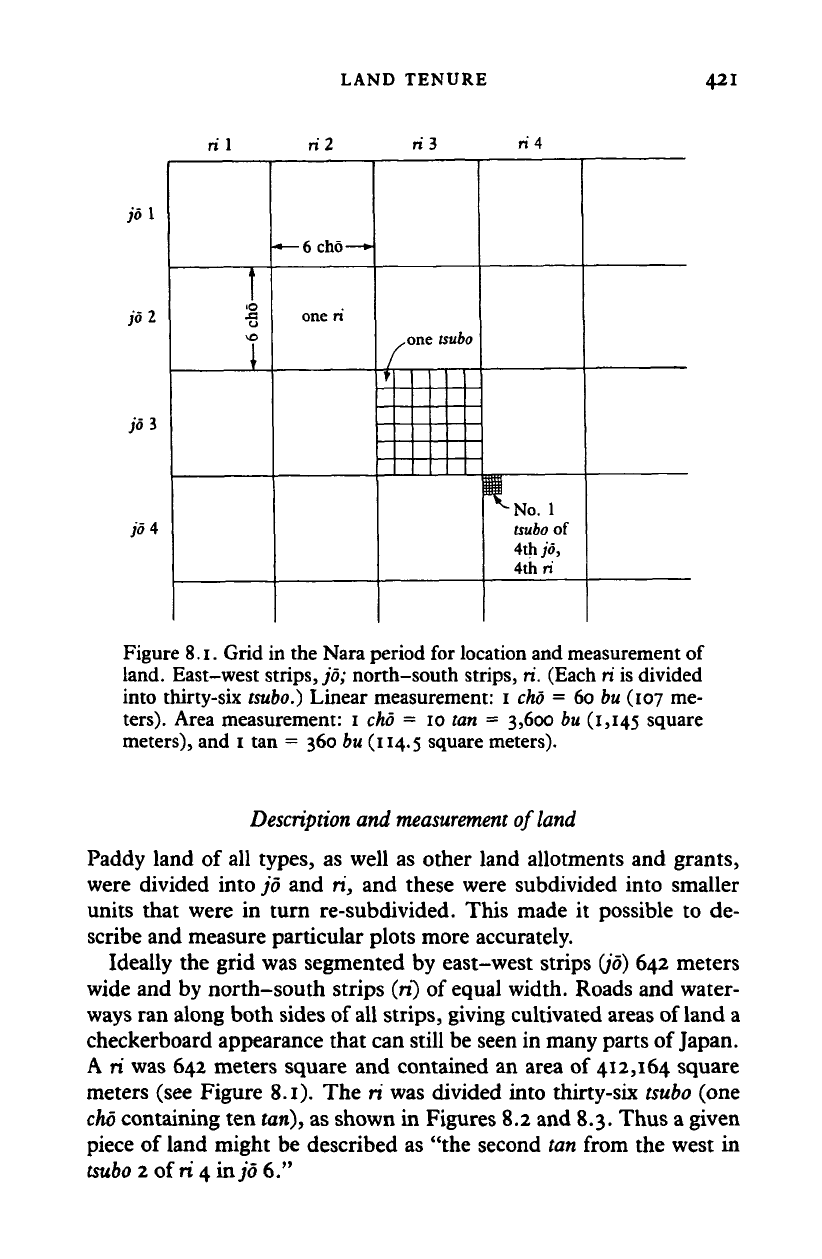
LAND TENURE
421
jo I
jo 2
jo 3
jo 4
rt 1
s
CJ
W2
•"—
6
cho
—•
one
ri
n i
.one
tsubo
T
ri4
^No.
1
tsubo
of
4th
;o,
4th ri
Figure 8.1. Grid in the Nara period for location and measurement of
land. East-west strips, jo; north-south strips,
ri.
(Each ri is divided
into thirty-six
tsubo.)
Linear measurement: 1
cho
= 60 bu (107 me-
ters).
Area measurement: 1 cho - 10 tan = 3,600 bu (1,145 square
meters), and
1
tan = 360 bu (114.5 square meters).
Description and
measurement
of land
Paddy land of all types, as well as other land allotments and grants,
were divided into jo and ri, and these were subdivided into smaller
units that were in turn re-subdivided. This made it possible to de-
scribe and measure particular plots more accurately.
Ideally the grid was segmented by east-west strips
(jo)
642 meters
wide and by north-south strips
(rt)
of equal width. Roads and water-
ways ran along both sides of all strips, giving cultivated areas of land a
checkerboard appearance that can still be seen in many parts of Japan.
A ri was 642 meters square and contained an area of 412,164 square
meters (see Figure 8.1). The ri was divided into thirty-six
tsubo
(one
cho
containing ten tan), as shown in Figures 8.2 and 8.3. Thus a given
piece of land might be described as "the second tan from the west in
tsubo
2 of ri 4 injd 6."
Cambridge Histories Online © Cambridge University Press, 2008
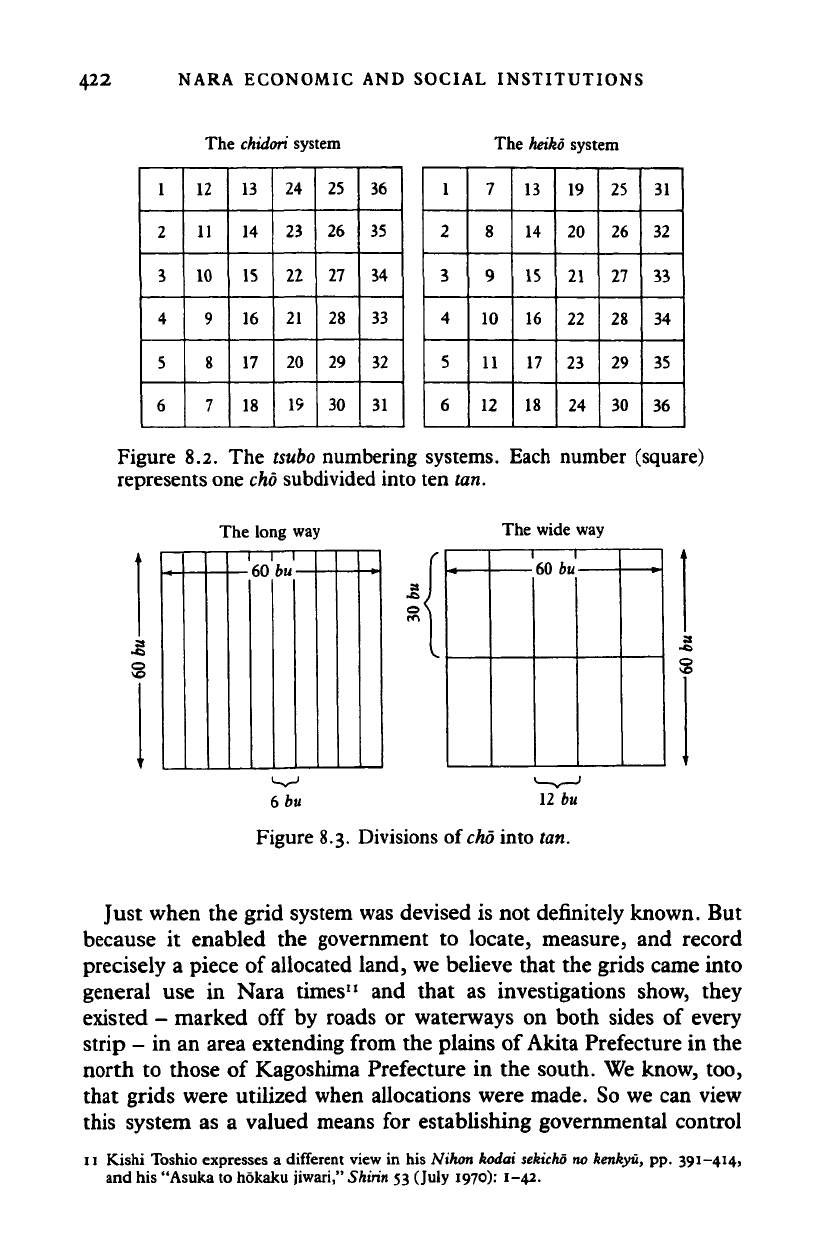
422
NARA ECONOMIC AND SOCIAL INSTITUTIONS
The
chidori
system
The
heiko
system
1
2
3
4
5
6
12
11
10
9
8
7
13
14
15
16
17
18
24
23
22
21
20
19
25
26
27
28
29
30
36
35
34
33
32
31
1
2
3
4
5
6
7
8
9
10
11
12
13
14
15
16
17
18
19
20
21
22
23
24
25
26
27
28
29
30
31
32
33
34
35
36
Figure
8.2. The
tsubo
numbering systems. Each number (square)
represents one
cho
subdivided into ten tan.
The long way
-60 b
The
wide
60 bu
way
6 bu
12 bu
Figure 8.3. Divisions of
cho
into tan.
Just when the grid system was devised
is
not definitely known.
But
because
it
enabled
the
government
to
locate, measure,
and
record
precisely
a
piece
of
allocated land, we believe that the grids came into
general
use in
Nara times"
and
that
as
investigations show, they
existed
-
marked
off by
roads
or
waterways
on
both sides
of
every
strip
- in an
area extending from the plains
of
Akita Prefecture
in the
north
to
those
of
Kagoshima Prefecture
in the
south. We know,
too,
that grids were utilized when allocations were made. So we can view
this system
as a
valued means
for
establishing governmental control
11 Kishi Toshio expresses
a
different view
in his
Nihon kodai
sekicho
no kenkyu,
pp.
391-414,
and
his
"Asuka
to
hokaku jiwari," Shirin
53
(July 1970):
1-42.
Cambridge Histories Online © Cambridge University Press, 2008
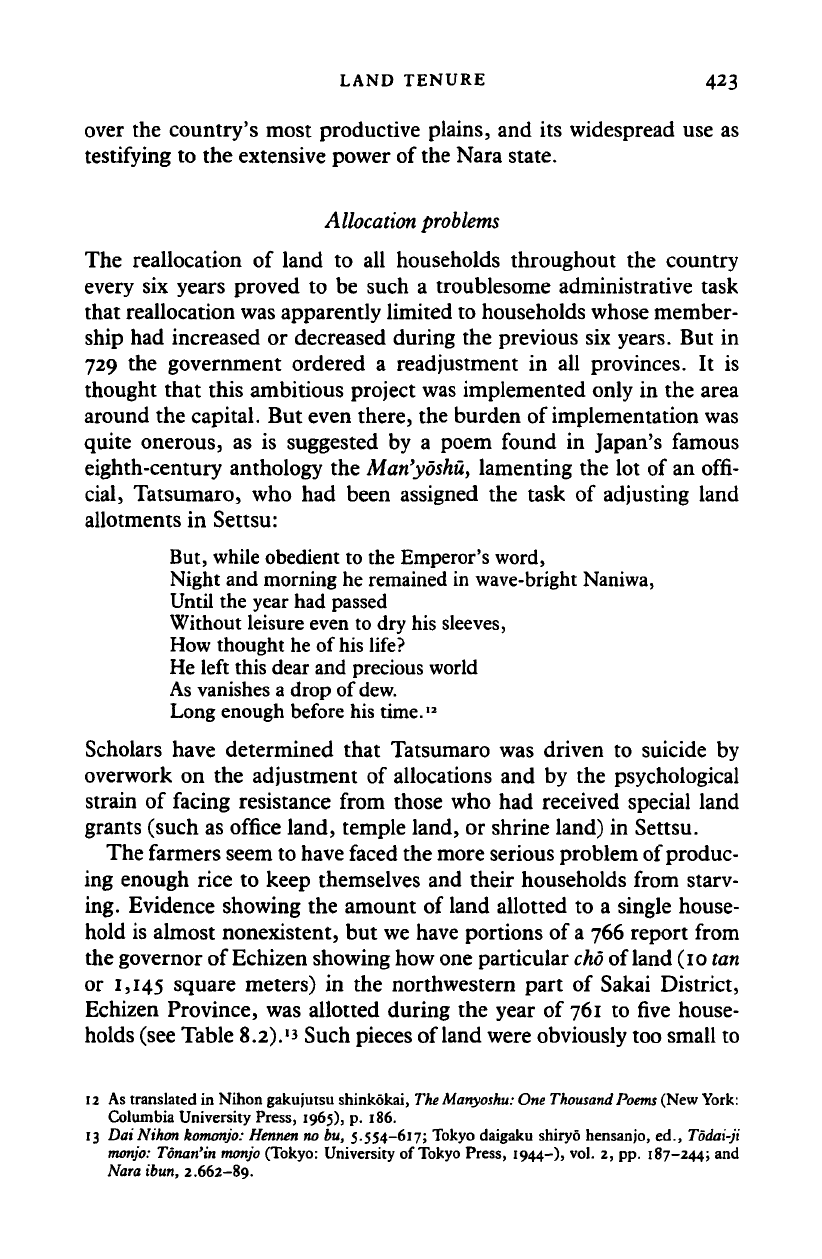
LAND TENURE 423
over the country's most productive plains, and its widespread use as
testifying to the extensive power of the Nara state.
Allocation
problems
The reallocation of land to all households throughout the country
every six years proved to be such a troublesome administrative task
that reallocation was apparently limited to households whose member-
ship had increased or decreased during the previous six years. But in
729 the government ordered a readjustment in all provinces. It is
thought that this ambitious project was implemented only in the area
around the capital. But even there, the burden of implementation was
quite onerous, as is suggested by a poem found in Japan's famous
eighth-century anthology the Man'yoshu, lamenting the lot of an offi-
cial, Tatsumaro, who had been assigned the task of adjusting land
allotments in Settsu:
But, while obedient to the Emperor's word,
Night and morning he remained in wave-bright Naniwa,
Until the year had passed
Without leisure even to dry his sleeves,
How thought he of
his
life?
He left this dear and precious world
As vanishes a drop of dew.
Long enough before his time.
12
Scholars have determined that Tatsumaro was driven to suicide by
overwork on the adjustment of allocations and by the psychological
strain of facing resistance from those who had received special land
grants (such as office land, temple land, or shrine land) in Settsu.
The farmers seem to have faced the more serious problem of produc-
ing enough rice to keep themselves and their households from starv-
ing. Evidence showing the amount of land allotted to a single house-
hold is almost nonexistent, but we have portions of a 766 report from
the governor of Echizen showing how one particular
cho
of land (10 fan
or 1,145 square meters) in the northwestern part of Sakai District,
Echizen Province, was allotted during the year of 761 to five house-
holds (see Table
8.2).'3
Such pieces of land were obviously too small to
12 As translated in Nihon gakujutsu shinkokai,
The
Manyoshu:
One
Thousand Poems
(New York:
Columbia University Press, 1965), p. 186.
13 Dai Nihon
komonjo:
Hennen
no bu, 5.554-617; Tokyo daigaku shiryo hensanjo, ed., Todai-ji
monjo:
Tonan'in
monjo
(Tokyo: University of Tokyo Press, 1944-), vol. 2, pp. 187-244; and
Nara ibun, 2.662-89.
Cambridge Histories Online © Cambridge University Press, 2008
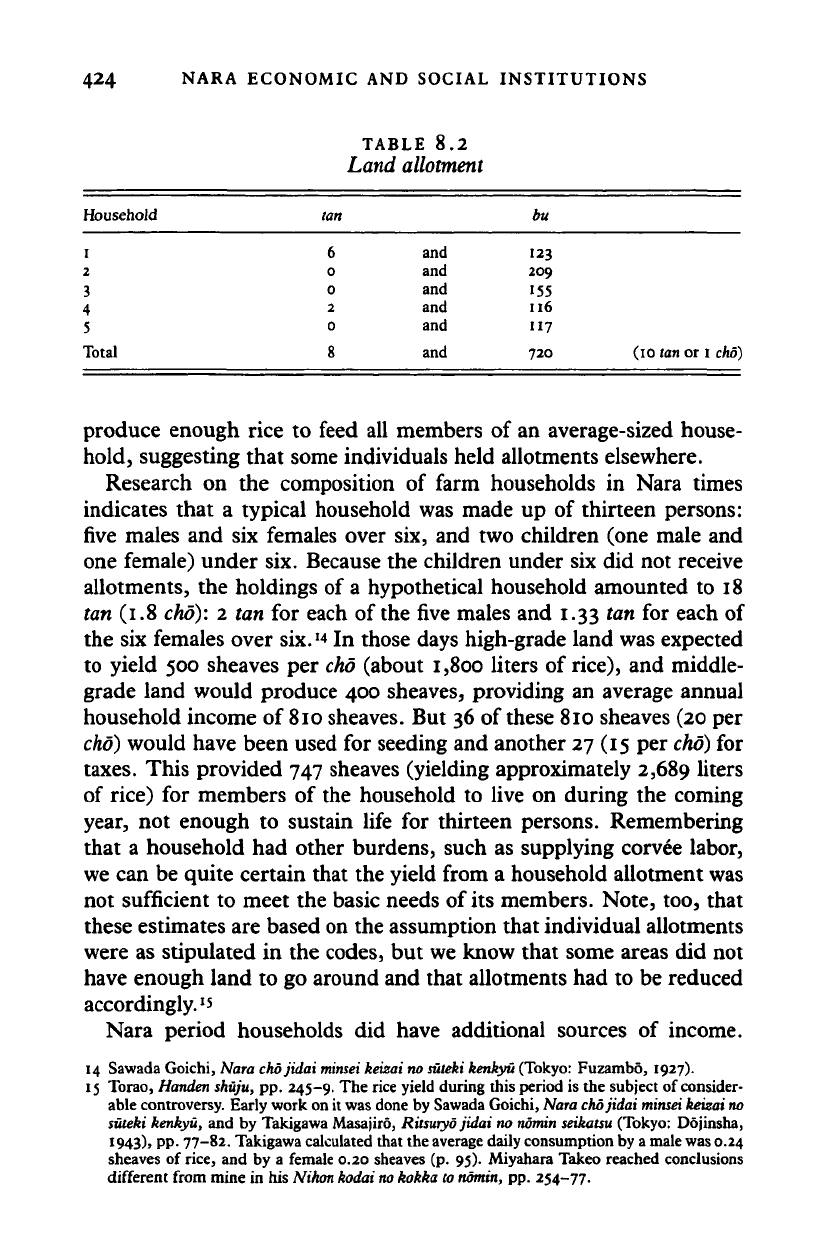
424 NARA ECONOMIC AND SOCIAL INSTITUTIONS
TABLE 8.2
Land allotment
Household tan bu
1 6 and 123
2 o and 209
3 o and 155
4 2 and 116
5 0 and 117
Total 8 and 720 (10 tan or 1 cho)
produce enough rice to feed all members of an average-sized house-
hold, suggesting that some individuals held allotments elsewhere.
Research on the composition of farm households in Nara times
indicates that a typical household was made up of thirteen persons:
five males and six females over six, and two children (one male and
one female) under six. Because the children under six did not receive
allotments, the holdings of a hypothetical household amounted to 18
tan (1.8
cho):
2 tan for each of the five males and 1.33 ton for each of
the six females over six.
14
In those days high-grade land was expected
to yield 500 sheaves per
cho
(about 1,800 liters of rice), and middle-
grade land would produce 400 sheaves, providing an average annual
household income of 810 sheaves. But 36 of these 810 sheaves (20 per
cho)
would have been used for seeding and another 27 (15 per
cho)
for
taxes.
This provided 747 sheaves (yielding approximately 2,689 liters
of rice) for members of the household to live on during the coming
year, not enough to sustain life for thirteen persons. Remembering
that a household had other burdens, such as supplying corvee labor,
we can be quite certain that the yield from a household allotment was
not sufficient to meet the basic needs of its members. Note, too, that
these estimates are based on the assumption that individual allotments
were as stipulated in the codes, but we know that some areas did not
have enough land to go around and that allotments had to be reduced
accordingly.
1
'
Nara period households did have additional sources of income.
14 Sawada Goichi, Nara chojidai
minsei
keizai no
suteki
kenkyu (Tokyo: Fuzambd, 1927).
15 Torao, Handen shuju, pp. 245-9. The rice yield during this period is the subject of consider-
able controversy. Early work on it was done by Sawada Goichi, Nara chojidai
minsei
keizai
no
suteki kenkyu, and by Takigawa Masajiro, Ritsuryo jidai no
nomin
seikatsu (Tokyo: Dojinsha,
1943),
pp. 77-82. Takigawa calculated that the average daily consumption by a male was 0.24
sheaves of rice, and by a female 0.20 sheaves (p. 95). Miyahara Takeo reached conclusions
different from mine in his Nikon kodai
no
kokka to
nomin,
pp. 254-77.
Cambridge Histories Online © Cambridge University Press, 2008
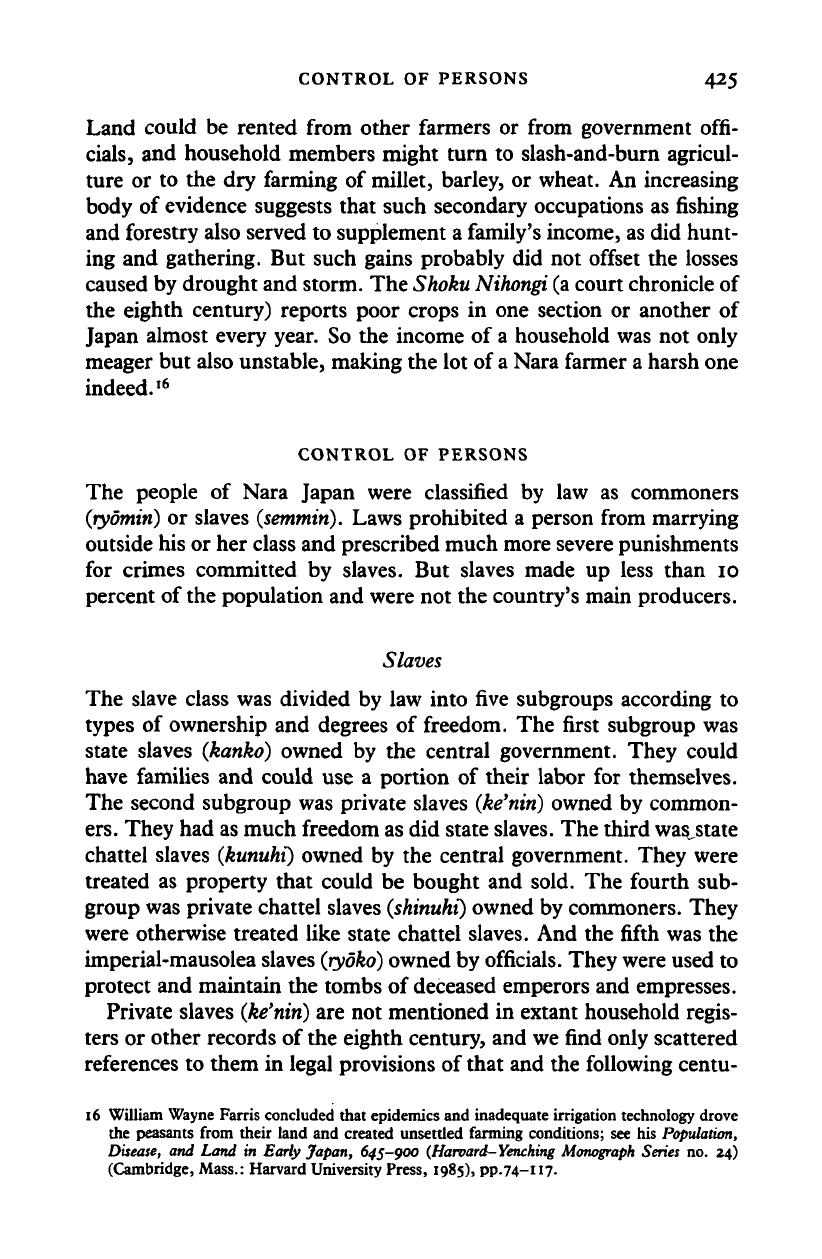
CONTROL OF PERSONS 425
Land could be rented from other farmers or from government offi-
cials,
and household members might turn to slash-and-burn agricul-
ture or to the dry farming of millet, barley, or wheat. An increasing
body of evidence suggests that such secondary occupations as fishing
and forestry also served to supplement a family's income, as did hunt-
ing and gathering. But such gains probably did not offset the losses
caused by drought and storm. The Shoku
Nihongi
(a court chronicle of
the eighth century) reports poor crops in one section or another of
Japan almost every year. So the income of a household was not only
meager but also unstable, making the lot of
a
Nara farmer a harsh one
indeed.
16
CONTROL OF PERSONS
The people of Nara Japan were classified by law as commoners
(ryomin)
or slaves
(semmin).
Laws prohibited a person from marrying
outside his or her class and prescribed much more severe punishments
for crimes committed by slaves. But slaves made up less than 10
percent of the population and were not the country's main producers.
Slaves
The slave class was divided by law into five subgroups according to
types of ownership and degrees of freedom. The first subgroup was
state slaves (kanko) owned by the central government. They could
have families and could use a portion of their labor for themselves.
The second subgroup was private slaves
(ke'niti)
owned by common-
ers.
They had as much freedom as did state slaves. The third was,state
chattel slaves
(kunuhi)
owned by the central government. They were
treated as property that could be bought and sold. The fourth sub-
group was private chattel slaves
(shinuht)
owned by commoners. They
were otherwise treated like state chattel slaves. And the fifth was the
imperial-mausolea slaves
{ryoko)
owned by officials. They were used to
protect and maintain the tombs of deceased emperors and empresses.
Private slaves
(ke'nin)
are not mentioned in extant household regis-
ters or other records of the eighth century, and we find only scattered
references to them in legal provisions of that and the following centu-
16 William Wayne Farris concluded that epidemics and inadequate irrigation technology drove
the peasants from their land and created unsettled farming conditions; see his Population,
Disease, and Land in Early Japan, 645-900
(Harvard—Yenching Monograph
Series no. 24)
(Cambridge, Mass.: Harvard University Press, 1985), pp.74-117.
Cambridge Histories Online © Cambridge University Press, 2008
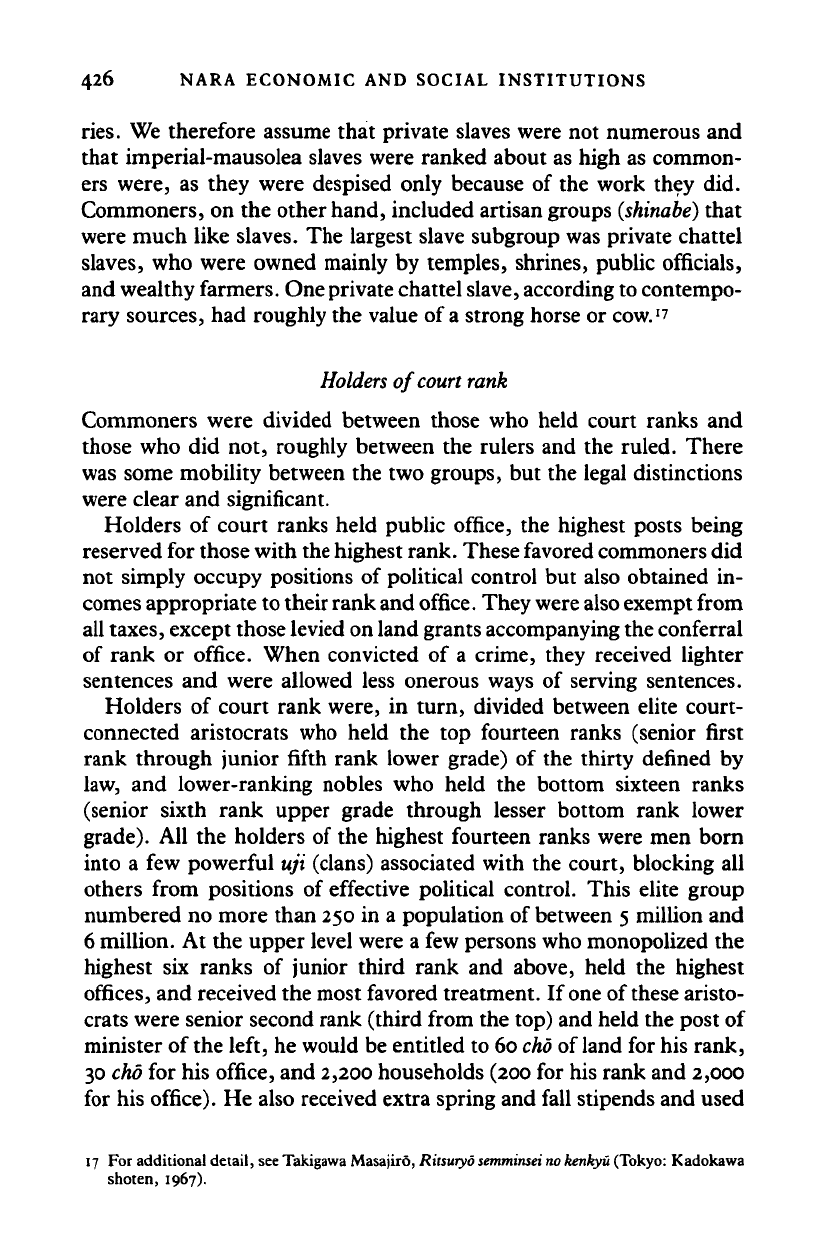
426 NARA ECONOMIC AND SOCIAL INSTITUTIONS
ries.
We therefore assume that private slaves were not numerous and
that imperial-mausolea slaves were ranked about as high as common-
ers were, as they were despised only because of the work they did.
Commoners, on the other hand, included artisan groups
(shinabe)
that
were much like slaves. The largest slave subgroup was private chattel
slaves, who were owned mainly by temples, shrines, public officials,
and wealthy farmers. One private chattel
slave,
according to contempo-
rary sources, had roughly the value of
a
strong horse or cow.'7
Holders
of court rank
Commoners were divided between those who held court ranks and
those who did not, roughly between the rulers and the ruled. There
was some mobility between the two groups, but the legal distinctions
were clear and significant.
Holders of court ranks held public office, the highest posts being
reserved for those with
the
highest rank. These favored commoners did
not simply occupy positions of political control but also obtained in-
comes appropriate to their rank and office. They were
also
exempt from
all taxes, except those levied on land grants accompanying the conferral
of rank or office. When convicted of a crime, they received lighter
sentences and were allowed less onerous ways of serving sentences.
Holders of court rank were, in turn, divided between elite court-
connected aristocrats who held the top fourteen ranks (senior first
rank through junior fifth rank lower grade) of the thirty defined by
law, and lower-ranking nobles who held the bottom sixteen ranks
(senior sixth rank upper grade through lesser bottom rank lower
grade).
All the holders of the highest fourteen ranks were men born
into a few powerful uji (clans) associated with the court, blocking all
others from positions of effective political control. This elite group
numbered no more than 250 in a population of between 5 million and
6 million. At the upper level were a few persons who monopolized the
highest six ranks of junior third rank and above, held the highest
offices, and received the most favored treatment. If one of these aristo-
crats were senior second rank (third from the top) and held the post of
minister of the left, he would be entitled to 60
cho
of land for his rank,
30
cho
for his office, and 2,200 households (200 for his rank and 2,000
for his office). He also received extra spring and fall stipends and used
17 For additional detail, see Takigawa Masajiro, Ritsuryo
semminsei no kenkyu
(Tokyo: Kadokawa
shoten, 1967).
Cambridge Histories Online © Cambridge University Press, 2008
